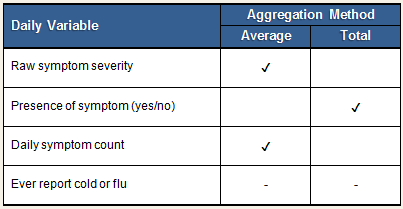Daily Symptoms (PCS2, PMBC, PCS3)
Title
Daily Interview Symptom Scale (PCS2, interview p. 2; PMBC, interview p. 6; PCS3, interview p. 7)
Copyright Information
Not a copyrighted scale
Primary References
Jackson, G. G., Dowling, H. F., Spiesman, I. G., & Boand, A. V. (1958). Transmission of the common cold to volunteers under controlled conditions. I. The common cold as a clinical entity. Archives of Internal Medicine, 101, 267-278.
Purpose
The scale is designed to assess whether and to what extent participants experienced several symptoms characteristic of upper respiratory illness (URI) during the past 24 hours.
Type of Measure
Created
Description
At the end of each interview, participants were read a list of 8 physical symptoms identified by Jackson and colleagues (1958) as being characteristic of the common cold, and asked to rate the severity of each symptom using a 5-point scale ranging from none to very severe. Participants also were asked whether they thought they had a cold or the flu, and in PMBC and PCS3, whether allergies had been giving them a problem that day. Daily symptom items can be found on the second page of the PCS2 interview form, on page 6 of the PMBC-unmarried form, and on page 7 of the PMBC-married and PCS3 forms. The 8 URI symptoms included in the evening interviews, as well as the scale used to rate them, are identical to the self-report questionnaire items that participants responded to while in quarantine (see Daily Symptoms in Quarantine).
Scaling
0 = none, 1 = mild, 2 = moderate, 3 = severe, 4 = very severe
Variables/Scoring
Because the daily telephone interviews administered in PCS2, PMBC, and PCS3 took place during the pre-challenge baseline period (i.e., 2-5 weeks before quarantine), symptoms assessed during this time were not directly relevant to infection with the challenge virus. Accordingly, with the exception of determining whether participants reported having a cold or flu on any day during the evening interview period (a criterion for exclusion from participation in the viral challenge component of the study), no variables relating specifically to colds were computed using interview data. Thus, in addition to the raw data, the dataset includes a smaller set of computed variables. Daily interview symptom variables and how they were aggregated across the interview period to create summary variables are displayed in table below.
